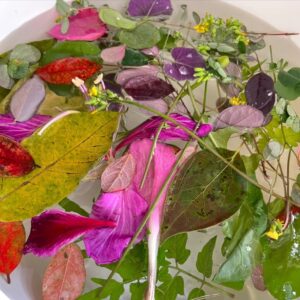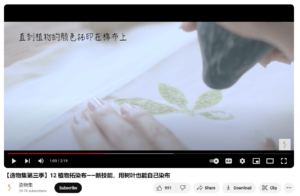From Plants to Images: The Artistic Transformation of Plant Power

Reading Time: 4 minutes
SUMMARY:
By exploring the natural colors and forms of plants, it provides a variety of creative means to transform the unique textures and visual effects of plants into artistic expression.
Nature is an endless treasure house of art, and the veins, petals and fruits of plants are rich in texture and color, which can be used as materials for artistic creation.
LIST OF MATERIALS AND TOOLS:
-
Plant material: Leaves and flowers collected from the roadside. (preferably: with distinct leaf veins, clear patterns, and darker colors)
-
If there are no fresh plants on the roadside in winter, you can try to choose some fresh vegetables (such as brassica campestris, coriander, celery, etc.)
-
Media of Creation: paper or cloth
Paper: Thick paper towels, napkins, handmade paper, cardboard, rice paper, etc.)
Cloth: Canvas bag,cotton, linen, silk, etc.
-
Tools
Hammering tools: stones,mallet, rubber mallet, stone anvil, etc., used for hammering plants.( It can be any hard object at hand.)
Auxiliary tools: Wide transparent tape/plastic sheet,scissors, pliers, workbench, water, etc.
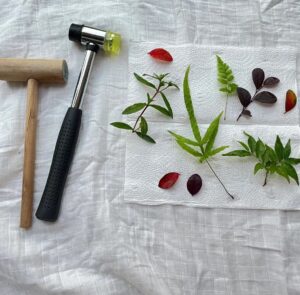
PRACTICE GUIDE:
NOTE: You can use any tools and methods you want here. The solution presented in the guide is not unique.
Please feel FREE to CREATE!
STEP1. Preliminary preparation(3 mins)
Choose plant materials: Select suitable plants, flowers, leaves, fruits, etc. Different plants produce different colors, and you can choose different plants according to the color effect.
(Try to avoid choosing hard, old, dry, oily wax plants, which are not easy to color)
-
The recommended choice of plants in winter are: brassica campestris, coriander, celery, etc.
(Picture reference)
Prepare the cloth/paper: Cut the cloth/paper to an appropriate size
(It is best to use natural materials, such as cotton, linen, etc., so that the natural pigment of the plant can be absorbed more).
STEP2.Cleaning Plants(2 mins)
Wash plants briefly with water and dry with paper towels. Wipe off as much water as possible to prevent color smudging.
(Fragile plants are not recommended to be washed in water, can be used directly)
STEP3. Place the plant material on the fabric: (2 mins)
Spread the plant material evenly on the fabric.
You can choose to pack them closer together or adjust the density of the plants as needed.
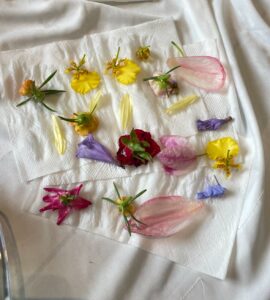
STEP4. Fixed plants(2 mins)
Place the plastic sheet, plastic film or paper on the plant, fix and protect the plant, and facilitate the next step.
(Note: Place the back side of the plant down and the smoother side up).
STEP5. Hammer the plant material(7 mins)
Use a hard thing (such as hammer, mallet or stone) to tap the plant to help it release the pigment. Start at the edges and work your way to the center. This process requires care to avoid excessive damage to the plant or fabric. The coloring can be observed according to the reverse side of the cloth or paper.
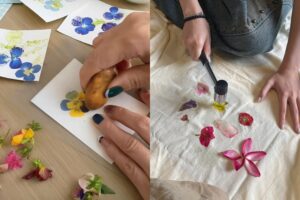
(You can choose any hard item to complete this step.)
If you need a video reference, please click the link below:
https://youtu.be/QuIBUKmM37c?si=0cF9xGVZjXJkn6Ko
STEP6. Complete creation
Keep tapping until you get an image you’re happy with. At this time, carefully uncover the paper towel or plastic film covered on the top, and then remove the plant, you can see the color of the plant and the image left on the plane.
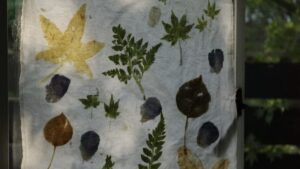
STEP7. Share and reflection (4 mins)
Take pictures of your work and try to discuss it with other participants.
You can talk about:
Different plants show different effects…
The effect of different media on the image…
The arrangement of different plants…
Different angles of hammering or hammering methods and different hammering tools…
……
Communicating everything related to the topic can help us get more information!
Plant reference © 2024 by ZIXUAN LIU is licensed under CC BY-SA 4.0
reference:
- buji, featured image, 2024, REDnote, https://www.xiaohongshu.com/discovery/item/660f3ef7000000001a015c5e?source=webshare&xhsshare=pc_web&xsec_token=CBcL62tVNWrsq5qipM1izNY4j9GDJ6VzkJOWFmuV_qOes=&xsec_source=pc_share
- 大湾区妈妈, Prepare materials and Clean plants, 2023, REDnote, https://www.xiaohongshu.com/discovery/item/643157ff0000000013004d1b?source=webshare&xhsshare=pc_web&xsec_token=CBNe4zLQwSI5c-TowWKSCmE9t7F7TdakNurXJ83buyiYk=&xsec_source=pc_share .
- 野生板栗, Plant placement and Hammer the plant material, 2024, REDnote, https://www.xiaohongshu.com/discovery/item/66d998d4000000001e01b728?source=webshare&xhsshare=pc_web&xsec_token=CByx3WdE02D7nrcsdhaHPhAqWmRTvNtfN6UnMRNYjgY4Y=&xsec_source=pc_share.
- April-flower, Hammer the plant material, 2024, REDnote, https://www.xiaohongshu.com/discovery/item/66c88ecf000000001f03de7d?source=webshare&xhsshare=pc_web&xsec_token=CBirMpZhQGY2LUdApQ1l7eifOyp-h-eyJYzzAczjuLaPk=&xsec_source=pc_share
- 造物集, “植物拓染布——新技能,用树叶也能自己染布,” Aug 12, 2017, video, 3:19, https://youtu.be/QuIBUKmM37c?si=0cF9xGVZjXJkn6Ko
(From Plants to Images: The Artistic Transformation of Plant Power © 2024 by ZIXUAN LIU is licensed under Creative Commons Attribution-ShareAlike 4.0 International )
(From Plants to Images: The Artistic Transformation of Plant Power © 2024 by ZIXUAN LIU is licensed under Creative Commons Attribution-ShareAlike 4.0 International )



